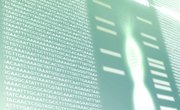
In gel electrophoresis, samples of DNA or proteins are separated -- typically based on size -- by applying an electric field that causes them to migrate through a gel. The use of gel electrophoresis is routine in biomedical research labs and is used to answer a variety of different questions, so there isn't really a universal way to analyze the results.
Different techniques like Western blotting, Northern blotting, and Southern blotting, for example, all involve gel electrophoresis.
If you're doing agarose gel electrophoresis of DNA samples, the most common kind of procedure, you'll typically need to do at least two things: 1) distinguish uncut plasmids from inserts, nicked plasmids and cut plasmids and, 2) estimate the size of the various DNA fragments with a standard curve Excel or calculator.
Here's how it works.
- Picture of your gel (taken with UV light, which makes the ethidium-bromide stained bands visible)
- Excel or other graphing program
- Ruler
If you see bright, wide bands in the bottom of every single lane, you probably have some RNA in your gel -- your purification protocol may be flawed.
Check your lab notebook to determine which samples were loaded into which lanes. When you loaded the wells for your gel, you should have noted the identity of each lane/sample.
Determine which lane contains the "ladder" of DNA standards. These are fragments of known length; their migration distance can be used to determine the size of the sample fragments using a standard curve Excel or another calculator.
Using a ruler, measure the distance on your picture from the wells to the tracking dye, which will have traveled further than any of the DNA bands (in other words, it will be at the bottom of the gel). Record this number -- the units you use aren't important.
Measure the distance on your picture from the wells to each of the bands in the "ladder," then divide that distance by the distance traveled by the tracking dye band. This calculation gives you the relative mobility of each band.
Example: Suppose the tracking dye band traveled 6 inches and we have three bands that traveled 5, 4.5 and 3.5 inches.
What is their relative mobility? Answer: We divide 5, 4.5 and 3.5 by 6 to obtain relative mobilities of 0.833, 0.75 and 0.5833.
Enter the relative mobilities into your spreadsheet program (Excel or any other similar program that you use) together with the size in kilobases of each fragment in the ladder.
The manufacturer gives you the size of each fragment in the ladders they supply, so you should already have this information.
Graph the data with relative mobility on the x and size in kilobases on the y.
Use the Trendline function on your spreadsheet program to fit an equation to the data. This equation should be a power equation (e.g. x^-2) and should fit the data relatively well (R-coefficient of at least 0.9). This creates a curve and a standard curve Excel.
Look at the bands corresponding to your samples.
Remember that smaller DNA fragments travel farther through the gel than large DNA fragments, so the ones closest to the tracking dye will be the smallest. Note, however, that if plasmid (circular) DNA is uncut, it will become "supercoiled" or twisted like a telephone cord, which will actually cause it to travel farther than linear DNA of the same size.
Likewise, a "nicked" plasmid that has been incompletely cut will travel a shorter distance than linear DNA of the same size. Consequently, you cannot estimate the size of uncut plasmids from your gel.
Match up the bands in each lane with the identity of the sample you loaded in that lane and determine whether what you see is what you would have expected. This will depend on the nature of your experiment.
In general, however, if you digested an insert plasmid with two restriction enzymes, you would expect the insert would be freed from the plasmid.
Since it is much smaller than the plasmid, you would expect to see two bands in that lane, one near the top and the other down near the bottom. A plasmid cut with only one restriction enzyme should form only a single band that travels a little farther than the plasmid cut with two restriction enzymes, but nowhere near as far as the insert.
Measure the distance from the wells to the cut plasmid and insert bands with your ruler. Divide these numbers by the distance traveled by the tracking dye to find relative mobility of inserts and cut plasmids.
Plug the relative mobility of inserts and cut plasmids into the equation your spreadsheet program calculated for you. This calculation should give you an estimate of the size of these plasmids.
Things You'll Need
Tips
References
Tips
- If you see bright, wide bands in the bottom of every single lane, you probably have some RNA in your gel -- your purification protocol may be flawed.
About the Author
Based in San Diego, John Brennan has been writing about science and the environment since 2006. His articles have appeared in "Plenty," "San Diego Reader," "Santa Barbara Independent" and "East Bay Monthly." Brennan holds a Bachelor of Science in biology from the University of California, San Diego.
Photo Credits
Jupiterimages/Comstock/Getty Images
